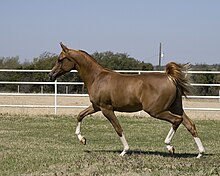The accessibility of this article is in question. Relevant discussion may be found on the talk page. (September 2024) |
This article needs additional citations for verification. (February 2013) |


The trot is a two-beat diagonal horse gait where the diagonal pairs of legs move forward at the same time with a moment of suspension between each beat. It has a wide variation in possible speeds, but averages about 13 kilometres per hour (8.1 mph). A very slow trot is sometimes referred to as a jog. An extremely fast trot has no special name, but in harness racing, the trot of a Standardbred is faster than the gallop of the average non-racehorse, and has been clocked at over 30 miles per hour (48 km/h).
On June 29, 2014, at Pocono Downs in Pennsylvania the Swedish standardbred Sebastian K trotted a mile in 1 minute, 49 seconds (quarters were passed at 26:2, 55:3 and 1,21:4). This is equivalent to a 1000-pace in 1.07,7 or 53.14 kilometers per hour or 33 miles per hour.
From the standpoint of the balance of the horse, the trot is a very stable gait and does not require the horse to make major balancing motions with its head and neck.[1] Due to its many variations, the trot is a common gait that the horse is worked in for dressage.
Eadweard Muybridge was the first to prove, by photography, in 1872 that there is a "moment of suspension" or "unsupported transit" during the trot gait.
- ^ Harris, Susan E. Horse Gaits, Balance and Movement New York: Howell Book House 1993 ISBN 0-87605-955-8 pp. 35–37